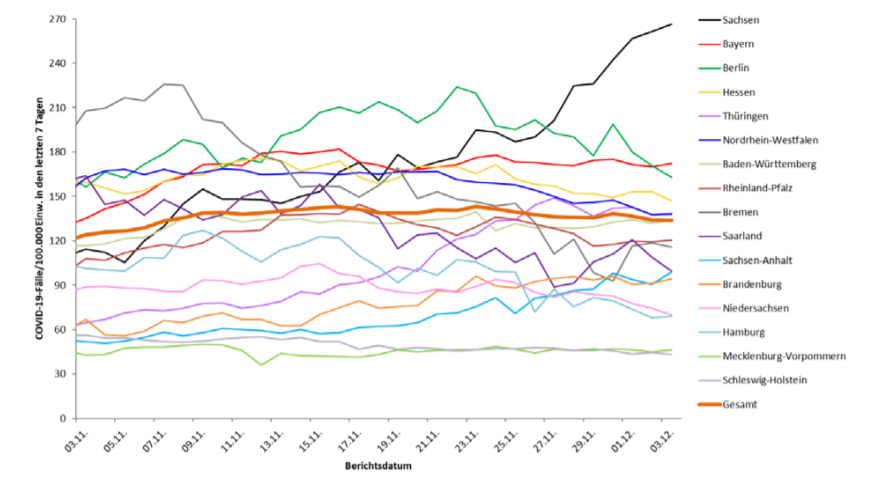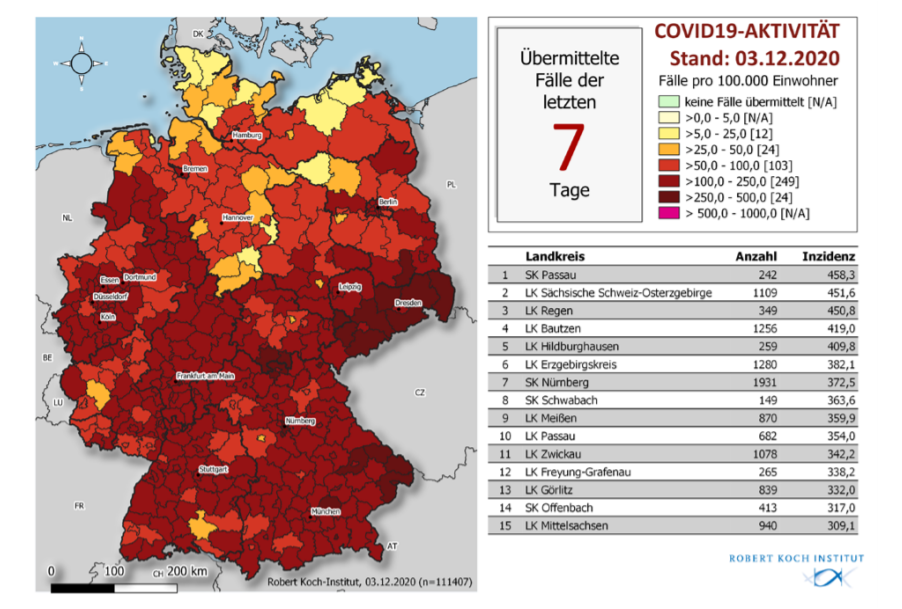These maps will help you understand the current state of the pandemic in Germany

Five weeks into the so-called “lockdown light” average daily cases have plateaued slightly below the 20,000 mark. But the spread of the virus varies markedly between regions, and even from town to town. We break down where the latest outbreaks have been.
The first thing that is interesting to note about the virus is that, generally speaking, it has hit the south and west of the country much harder than the north since the beginning of the pandemic.
The two northernmost states, Schleswig-Holstein and Mecklenburg-Western Pomerania both have infection rates of less than 50 per 100,000 people at the moment.

Source: Robert Koch Institute
The east of Germany is an interesting anomaly. It was barely hit by the first wave back in March. But, while cases have been dropping elsewhere for several weeks, they have skyrocketed in Saxony. The eastern state now has a case weight of 330 per 100,000. This high number is putting a strain on hospitals in parts of the state.
Thuringia, Brandenburg and Saxony-Anhalt, which all had low case rates in the spring, have also seen infections rise during the lockdown, albeit to a lesser extent than in Saxony.
Of the city states, Hamburg has seen the biggest fall in cases since the beginning of November. They peaked at 172 per 100,000 on November 13th but have since dropped back to 96 per 100,000. But cases have also dropped off in Berlin and Bremen.
READ ALSO: Germany records 23,449 new Covid-19 cases amid call for tighter regional restrictions
In terms of the cumulative death rate, Bavaria has a considerably higher mortality in relation to its population than any other federal state, with 30.9 deaths per 100,000.
The state with the second highest death rate is Saxony, which has had 26.6 deaths per 100,000 inhabitants since the start of the crisis.
At the bottom end of the scale in terms of deaths is Mecklenburg-Western Pomerania, which has had just 4.2 deaths per 100,000 inhabitants. Berlin is solidly in the middle in terms of fatalities, with 16.8 deaths per 100,000 inhabitants since the start of the epidemic.
District level hotspots
On the more granular level, we can see that there are significant differences in infection rates inside the various federal states.
The current district with the largest number of cases per head of population is Passau in the south-eastern corner of Bavaria, which currently has 458 cases per 100,000. Also hard hit are the rural regions outside of Dresden and Chemnitz in southern Saxony.
Meanwhile the district with the highest case rate over all is Nuremberg, with 1,931 cases reported over the past week.
Both Passau and Nuremberg have introduced stricter lockdowns, only allowing residents to leave their homes for "essential reasons."

The district with the lowest current caseload is Nordfriesland, right up in the northwest corner of the country. It has only had 22 positive cases in the last week and has recorded just four Covid deaths since the start of the pandemic.
Situation in hospitals
In terms of the current strain on intensive care beds, the chart below shows that the east of Bavaria and the east of Saxony are facing the greatest strain on their clinical resources.
Anteil der COVID-19 PatientInnen an der Gesamtzahl der Intensivbetten (Kreisebene) https://t.co/3T5CdVoBmO
— Jörg Luyken (@jorgluyken) December 4, 2020
In the Erzgebirgskreis in Saxony, just three of the district’s 80 intensive care beds are free, with close to two thirds of the beds being taken up by corona patients.
Mühldorf am Inn in Bavaria is facing a similarly tough situation in ICU with only one of its 16 beds still available. Showing just how large local differences can be, none of the ICU beds in nearby Kelheim are taken up by Covid-19 patients.
The situation is most relaxed near the Danish border, where none of the intensive care beds are taken up by Covid-19 patients.
Overall, some 5,000 intensive care beds are still available nationwide, with corona patients occupying close to 4,000 beds.
Comments (2)
See Also
The first thing that is interesting to note about the virus is that, generally speaking, it has hit the south and west of the country much harder than the north since the beginning of the pandemic.
The two northernmost states, Schleswig-Holstein and Mecklenburg-Western Pomerania both have infection rates of less than 50 per 100,000 people at the moment.

Source: Robert Koch Institute
The east of Germany is an interesting anomaly. It was barely hit by the first wave back in March. But, while cases have been dropping elsewhere for several weeks, they have skyrocketed in Saxony. The eastern state now has a case weight of 330 per 100,000. This high number is putting a strain on hospitals in parts of the state.
Thuringia, Brandenburg and Saxony-Anhalt, which all had low case rates in the spring, have also seen infections rise during the lockdown, albeit to a lesser extent than in Saxony.
Of the city states, Hamburg has seen the biggest fall in cases since the beginning of November. They peaked at 172 per 100,000 on November 13th but have since dropped back to 96 per 100,000. But cases have also dropped off in Berlin and Bremen.
READ ALSO: Germany records 23,449 new Covid-19 cases amid call for tighter regional restrictions
In terms of the cumulative death rate, Bavaria has a considerably higher mortality in relation to its population than any other federal state, with 30.9 deaths per 100,000.
The state with the second highest death rate is Saxony, which has had 26.6 deaths per 100,000 inhabitants since the start of the crisis.
At the bottom end of the scale in terms of deaths is Mecklenburg-Western Pomerania, which has had just 4.2 deaths per 100,000 inhabitants. Berlin is solidly in the middle in terms of fatalities, with 16.8 deaths per 100,000 inhabitants since the start of the epidemic.
District level hotspots
On the more granular level, we can see that there are significant differences in infection rates inside the various federal states.
The current district with the largest number of cases per head of population is Passau in the south-eastern corner of Bavaria, which currently has 458 cases per 100,000. Also hard hit are the rural regions outside of Dresden and Chemnitz in southern Saxony.
Meanwhile the district with the highest case rate over all is Nuremberg, with 1,931 cases reported over the past week.
Both Passau and Nuremberg have introduced stricter lockdowns, only allowing residents to leave their homes for "essential reasons."

The district with the lowest current caseload is Nordfriesland, right up in the northwest corner of the country. It has only had 22 positive cases in the last week and has recorded just four Covid deaths since the start of the pandemic.
Situation in hospitals
In terms of the current strain on intensive care beds, the chart below shows that the east of Bavaria and the east of Saxony are facing the greatest strain on their clinical resources.
Anteil der COVID-19 PatientInnen an der Gesamtzahl der Intensivbetten (Kreisebene) https://t.co/3T5CdVoBmO
— Jörg Luyken (@jorgluyken) December 4, 2020
In the Erzgebirgskreis in Saxony, just three of the district’s 80 intensive care beds are free, with close to two thirds of the beds being taken up by corona patients.
Mühldorf am Inn in Bavaria is facing a similarly tough situation in ICU with only one of its 16 beds still available. Showing just how large local differences can be, none of the ICU beds in nearby Kelheim are taken up by Covid-19 patients.
The situation is most relaxed near the Danish border, where none of the intensive care beds are taken up by Covid-19 patients.
Overall, some 5,000 intensive care beds are still available nationwide, with corona patients occupying close to 4,000 beds.
Join the conversation in our comments section below. Share your own views and experience and if you have a question or suggestion for our journalists then email us at [email protected].
Please keep comments civil, constructive and on topic – and make sure to read our terms of use before getting involved.
Please log in here to leave a comment.